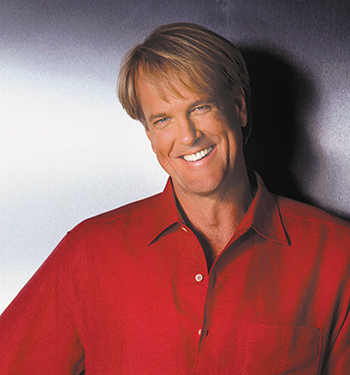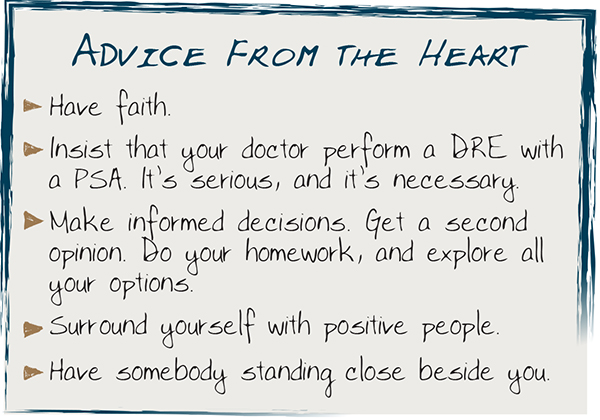Prostate Cancer Survivor
Embrace the promise of health and wellness

Emmy award-winning entertainer, author, radio host and musician John Tesh has been sharing his talents with international audiences for years. With the launch of his 24/7 live streaming platform, TeshTV, he and wife Connie Sellecca and son Gib Gerard are able to share the messages of hope and inspiration that are guiding him through the biggest challenge of his life: managing a rare Stage IV non-PSA producing prostate cancer diagnosis.
John Tesh has experienced firsthand that cocktail party conversations can turn to the topic of cancer when someone is aware of his diagnosis. But, each time a friend tells him he just had his PSA tested and everything is fine, John always asks a very important follow-up question.
“I ask if that PSA was accompanied by a digital rectal exam (DRE),” he explained. “Men typically don’t want to do that part of the exam, but it is necessary. And, for me, it was lifesaving.”
John was diligent about regular checkups, and his PSA was never elevated. But, during an annual physical, his doctor felt a difference during the DRE that prompted him to order an ultrasound and a biopsy.
“Had my doctor not been so thorough, I firmly believe I wouldn’t be here today,” John said.
The ultrasound showed six tumors, and the pathology report identified three as being Gleason 9s. Because John had no symptoms and wasn’t expecting to have any issues, the diagnosis of adeno-carcinoma of the prostate at 63 was even more shocking.
The urologist explaining the diagnosis basically told John to get his affairs in order. He and Connie didn’t accept that.
Researching is second nature to them, and they immediately started digging. John found a book written by an internationally recognized expert on prostate cancer who is affiliated with a well-known hospital across the country.
“He talked about nerve-sparing robotic surgery,” John said. “It was very interesting, and I needed to learn more. I took a chance and called him but introduced myself as a journalist.”
After fielding John’s very pointed questions for a few minutes, the specialist said, “You sound like a journalist who has prostate cancer.” A little ashamed for not having been completely honest in his approach, John said, “Yes, sir, I am.”
“Graciously, he continued to talk with me. I told him my PSA hadn’t risen, assuming that was a good thing. On the contrary, he said that meant it was a rare, non-PSA producing prostate cancer and suggested I get to his hospital as soon as possible. I asked if he would be my surgeon, and my heart sank when he told me he no longer performed surgery. However,” John went on, “he said the man he trained could save my life. Connie and I flew out immediately.”
John had a nerve-sparing radical prostatectomy. Although he had post-surgical complications that were challenging, the surgery itself was successful. Still, the experience of receiving such a grim diagnosis took its toll on him emotionally. He admits he leaned more on alcohol and painkillers than he should have. It took an ultimatum from Connie to bring him out of it.
“She told me in no uncertain terms that I had to shape up. She had been working so hard to keep me alive, and I seemed to be doing the opposite. I came to my senses, got into therapy and focused on healing.”
Visualizing success
Healing took on a new meaning when John combined his faith with his reliance on medical science.
“Connie and I have both believed in the word of God since we were children. God wants us to be well, and we live with that promise of health and wellness. Granted, life is not without suffering. That is just part of the deal.”
Though fearing for his life and managing the severe complications post-surgery were incredibly difficult, he tried to put his own experiences into perspective. Reading books by Holocaust survivors Viktor Frankl and Elie Wiesel helped immensely. “That,” he emphasized, “is suffering.”
Visualization – imagining that he already has what he is praying for – is another powerful tool John uses.
“In my days at CBS Sports, I covered many of the world’s top athletes in skiing, swimming, ice skating and other sports. They were all extremely talented but the common bond shared by those who won was that they could close their eyes and see every gate on the ski slope or every lap in the pool, all the way to the finish line. I visualize what I pray for – a long and healthy life for myself – 98 to be exact!”
After John’s prostatectomy, his surgeon gave him advice he didn’t truly understand at the time.
“He said that having prostate cancer is a journey. That began to sink in several months after the surgery when cancer was found in one of my lymph nodes. Six months after that, another was found. I needed an oncologist and more treatment. After more research, Connie and I traveled to a leading cancer center in a different part of the country.”
Another leg of the journey
There they met with an oncologist who became the newest member of John’s medical team. He ordered a PET, and the affected lymph nodes lit up. The doctor shared his approach, which was to treat John’s quality of life, not just the cancer. They discussed treatment options and potential side effects, and John and Connie asked many questions. It was obvious they had done their research.
“More than once, the doctors we met with asked Connie if she had a medical background,” he said.
Because John’s prostate cancer was hormone-driven, his oncologist recommended hormone therapy and chemotherapy. The goal was to slow the spread of cancer to a crawl.
“The hormone therapy gave me night sweats, and I couldn’t sleep.” He joked that he basically turned into a menopausal woman but admitted that hormone therapy, though it was effective, was the toughest part of his treatment.
“I never thought it’d be this long of a journey,” John admitted. “I thought I’d have surgery and be done with cancer.”
But, that hasn’t been the case. Over several years, the cancer has returned three times. Each time, John and his medical team have treated it successfully. He has witnessed the advances happening in prostate cancer treatment and is confident that as he continues follow-up appointments, he will have more options in the future.
“It’s important to recognize the difference between worry and vigilance. Worry will keep you up at night, thinking about the ‘what ifs.’ Vigilance is knowing your plan and sticking to it, which means never ignoring your follow-up exams. When you have prostate cancer, you can’t fall asleep at the wheel.”
To stay fit, John gets to the gym. “Working out is a great equalizer for me.”
Support and an advocate are necessary
John is grateful for Connie and the family, friends and medical team that make up his strong support system. Through their journey, they discovered that some of their friends weren’t comfortable with how to react in the face of suffering and grief. On the flipside, they were amazed at the selflessness displayed by others.
“We had many friends who dropped off food on the doorstep or sent prayers. My college roommate, Steve, texts every three or four days just to check on me. These are friends that see we’re on a victorious mission, and they support us.”
He stresses the importance of having an advocate standing by you, whether it is a spouse, loved one or friend. That support helps because prostate cancer is more than just a physical ailment.
“Prostate cancer is a couple’s disease,” John explained. “It may take place in a man’s engine room, but it tests both of you. Connie was already focused on managing 24-hour care for her mother as well as on her career, yet she gave up everything to help me. She stood by my side unconditionally, and we worked together with a constant vision of healing.”
As they continue the ups and downs involved in a cancer journey, they find that humor helps. John recently battled sepsis, a condition that could have been deadly, and Connie deflated the tense conversation with the doctor by responding with a Monty Python quip, “Well, that’s cast rather a gloom over the evening, hasn’t it?”
“I think the doctor didn’t know how to react,” John laughed.



